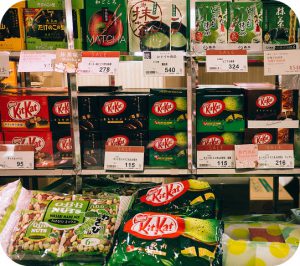 Visit the candy section of any American drug store and you’ll likely find some Kit Kats stocked unceremoniously alongside an assortment of other brands. But at the Don Quijote market in Tokyo, the chocolate-covered wafer bars occupy a place of honor in the megastore’s vast candy section. That’s because the seven-story market is one of the few places where consumers can browse through dozens of Kit Kat varieties developed exclusively for the Japanese market. From fruit-based variations to bolder flavors like purple sweet potato or wasabi, the candy’s distributor Nestle has released almost 400 different flavors in the country since the early 2000s.
Visit the candy section of any American drug store and you’ll likely find some Kit Kats stocked unceremoniously alongside an assortment of other brands. But at the Don Quijote market in Tokyo, the chocolate-covered wafer bars occupy a place of honor in the megastore’s vast candy section. That’s because the seven-story market is one of the few places where consumers can browse through dozens of Kit Kat varieties developed exclusively for the Japanese market. From fruit-based variations to bolder flavors like purple sweet potato or wasabi, the candy’s distributor Nestle has released almost 400 different flavors in the country since the early 2000s.
Back then, the marketing department at the company’s Japan office was experimenting with ways to increase Kit Kat sales in the region. They eventually decided to release a new pink-colored bar flavored with strawberry, which would probably be a risky choice anywhere else in the world. Since strawberry sweets are fairly common in Japan, though, the colorful Kit Kat turned out to be an instant success. Soon the company was coming up with all sorts of interesting flavors, including Tokyo Banana and green tea. Nestle now releases approximately 40 different varieties each year, with 20 to 30 rotating flavors that are available for a limited time.
Then there are the high-end Kit Kats developed by Yasumasa Takagi, a classically trained pastry chef. Since 2005 he and a team of food scientists have come up with sophisticated varieties like passion fruit and “special strawberry maple.” These flavors are then packaged in boxes that look like impeccably wrapped gifts and sold at the Kit Kat Chocolatory, a chain of candy stores designed to resemble luxury clothing boutiques. The company’s “Chocolatory Special Bitter” flavor, for instance, comes in a single long bar packaged in a sleek black and gold box. And while Nestle’s non-premium flavors can’t boast such interesting packaging, they certainly come in all sorts of sizes. In fact, the company estimates it sells 4 million individually wrapped Kit Kats every day. Coupled with their high-end varieties, it’s no wonder why Japan ranks as the candy’s top market in terms of sales and profits.
Questions:
- Why does Nestle develop so many varieties of Kit Kats in Japan?
- How does Nestle’s chain of Kit Kat Chocolatory stores help to build the candy’s brand?
Source: Tejal Rao, “Big In Japan,” The New York Times, October 24, 2018. Photo by Marco Carag.
